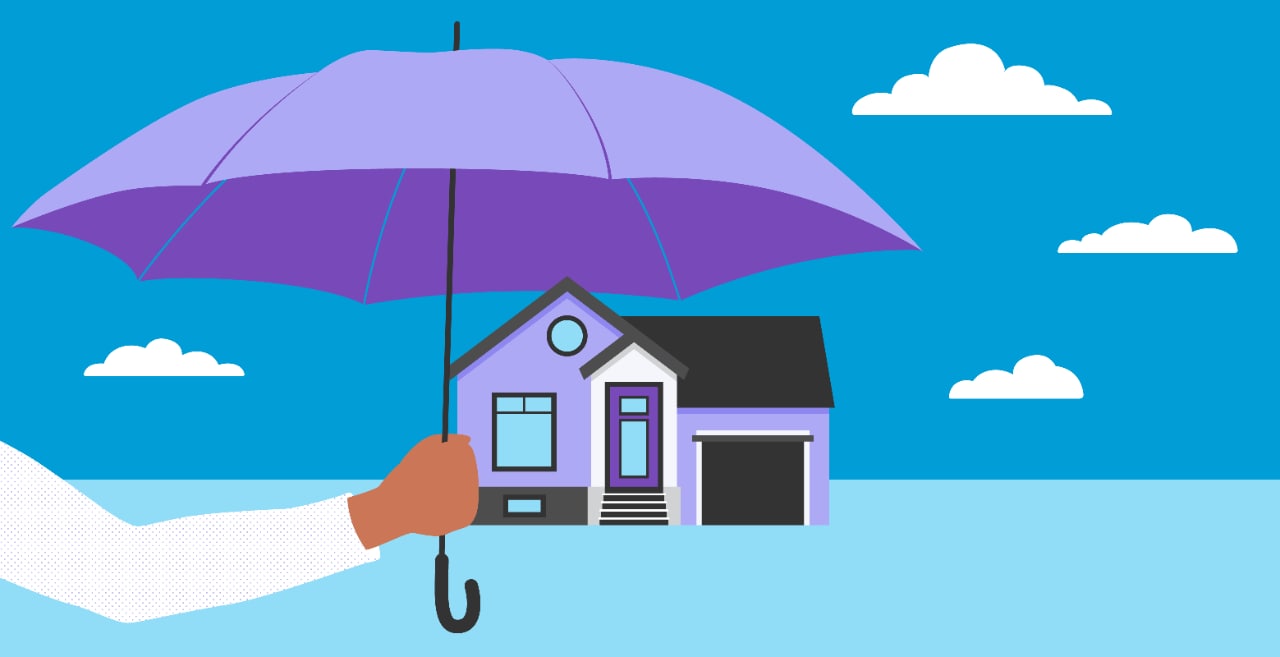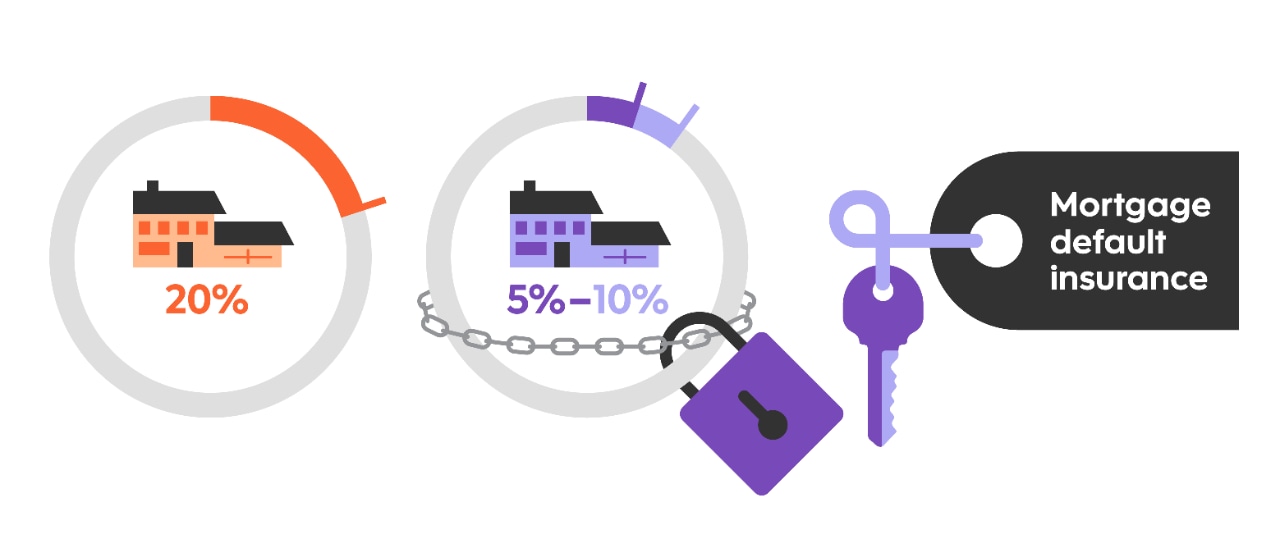Ready to buy a house, but worried about the size of your down payment? You might need to get mortgage default insurance.
Mortgage default insurance protects lenders. But it's also helpful for you, the homebuyer, because it gives you the opportunity to own a home even if you don't have a large down payment.
Think of it this way: Mortgage default insurance is like the key that unlocks the door to your dream home. Without that key, you may not be able to access the financing you need to make your homeownership dreams a reality.

For many Canadians, buying a home is a major financial goal. But what happens if you fall short of the recommended down payment of 20% of the purchase price? After all, even saving the 5% minimum down payment is challenging enough — getting to that 20% threshold can feel out of reach.
Enter, mortgage default insurance.

Here's how mortgage default insurance works: When homebuyers don’t have access to a 20% down payment, their mortgages are known as high-ratio mortgages. And mortgage default insurance is mandatory for all high-ratio mortgages in Canada.
This type of insurance provides protection for your lender, in case a borrower defaults on their mortgage payments. It also allows homebuyers to obtain a mortgage using a smaller down payment.
Mortgage default insurance is different from optional mortgage protection insurance, which can help pay off your mortgage, or help you keep up with your payments, in the event of certain unexpected life events such as death, critical illness, disability or job loss.
In Canada, mortgage default insurance is offered by the Canada Mortgage and Housing Corporation (CMHC), Sagen and Canada Guaranty. All of these companies are recognized as mortgage default insurance providers.
If your lender determines you need mortgage default insurance, it will arrange for you to get the insurance through one of the three insurers with your mortgage application.
You can’t refuse to get mortgage default insurance if your down payment for your home purchase is less than 20% of the purchase price. Since default insurance is mandatory in those situations, you’ll need this type of insurance to move forward with securing the mortgage loan.
There’s also a limitation for homes that cost more than $1,000,000. If the purchase price of the home you’re buying is over $1,000,000, you won’t qualify for mortgage default insurance, so you’ll need a down payment of 20% or more.
But if you do have a down payment of 20% or more, mortgage default insurance isn't mandatory by law. So, the best way to avoid having to get mortgage default insurance is to have at least a 20% down payment.
It is important to note that even if your down payment meets this 20% threshold, your lender may still require you to obtain mortgage default insurance if they've assessed the transaction as higher risk. While you don't have to get the mortgage default insurance, you may need to seek out alternative lending options to finance your mortgage with a lender who will not require the mortgage default insurance.
Like any insurance, mortgage default insurance requires a premium payment. But how this payment is made is different from other types of insurance.
As the borrower, you're responsible for paying the mortgage default insurance premium. The mortgage default insurance premium is calculated up front (when your mortgage is funded) and paid initially by your lender on your behalf. This premium is then added to the principal amount of the mortgage by your lender. So then you'll repay the lender through your mortgage payments. So rather than making a one-time payment, you'll repay the premium over the same amortization period as your mortgage.
Sales tax on the premium (if your province or territory charges provincial sales tax on insurance premiums) isn't included in the premium amount that's added to your mortgage principal. So, unlike the premium itself, the sales tax is a one-time lump sum payment you'll pay upfront as part of your closing costs.
On closing day, your lender will pay the insurer by deducting both the sales tax and premium from the principal amount advanced. You'll have already paid the sales tax to the lender as part of closing, and the premium will have been added to the principal amount of the loan.
The amount of your mortgage default insurance premium isn't based on your mortgage rate. Instead, it's calculated based on a percentage of the principal amount of your loan. The percentage is determined by your loan to value ratio.
Here's how the loan-to-value ratio is calculated:
- principal mortgage amount (excluding premium) ÷ purchase price or market value if lower (lending value).
Let's say the purchase price of the property you're buying is $500,000, and you're making a 10% down payment of $50,000. The principal amount of your mortgage would be $450,000 (500,000 - 50,000) and your loan to value ratio would be 90% (450,000 ÷ 500,000). (Note that a larger down payment will give you a lower loan to value ratio.)
The following table shows an example of premium percentages the insurance provider will use to calculate your premium, based on your loan-to-value ratio. (The "premium on increase to loan amount (top-up premium)" listed in the table below are the percentages that may apply if you refinance your insured mortgage.)
| Loan-to-value ratio | Premium on total loan amount | Premium on increase to loan amount (top-up premium) |
| Up to and including 65%. | 0.60% | 0.60% |
| Up to and including 75% | 1.70% | 5.90% |
| Up to and including 80% | 2.40% | 6.05% |
| Up to and including 85% | 2.80% | 6.20% |
| Up to and including 90% | 3.10% | 6.25% |
| Up to and including 95% | 4.00% | 6.30% |
The insurer will calculate the premium based on the percentage that corresponds to your loan-to-value ratio.
Let's use the numbers from the loan-to-value ratio example above to help illustrate how the mortgage default insurance premium is calculated:
- Mortgage loan amount: $450,000
- Loan to Value ratio: 90%
- Premium on Total Loan Amount (from the table above): 3.10%
- Based on these numbers, the premium payable would be: premium on total loan amount x mortgage loan amount = 3.10% x $450,000 = $13,950
If you decide to port the terms of your mortgage to a new home — for example, the interest rate, remaining term and remaining amortization and balance — or switch your mortgage to another lender, you may be eligible for the mortgage default insurance provider's portability program, if the new lender uses the same mortgage default insurer. By doing so, you may be able reduce or eliminate the premium on your new mortgage.
Even if you aren't eligible for the insurer's portability program, if you're able to port or switch your mortgage with no change to the loan-to-value ratio, loan amount or amortization period, an additional premium might not be required.
Since the amount of your mortgage insurance premium is added to the principal amount of your mortgage loan, you'll repay it over the same amortization period as your mortgage.
While the premium is typically non-refundable, if you purchase an energy-efficient home or make energy-saving renovations, you might be eligible for a partial refund of your mortgage insurance premium. For example, CMHC offers the CMHC Eco Plus program, which offers a 25% refund of your premium.
Takeaways
Mortgage default insurance is an important part of the home buying process for many Canadian homebuyers. It makes homeownership possible even if you have a smaller down payment.
By taking the time to learn more about mortgage default insurance and how the premium is calculated and paid, you can better navigate the home buying process and set yourself up for success as a homeowner.


